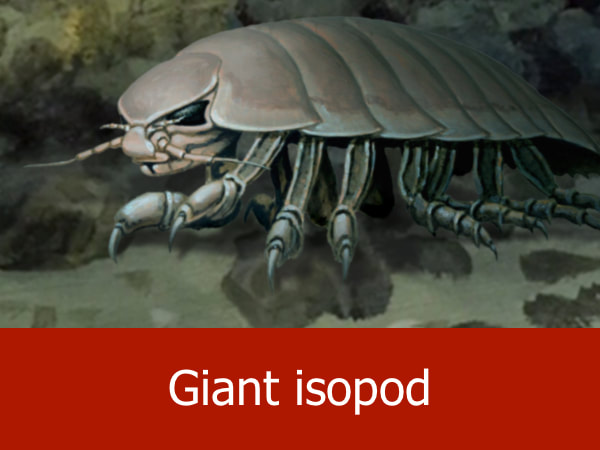Navigate:VIRTUAL EXPLORATIONS > ARCHIVED EXPLORATIONS > CREEP INTO THE DEEP 2015
|
Part 3: Meet the Giant IsopodGuest Contributor: Dr. Tammy Frank, Chief Scientist and Deep-sea Explorer
Posted July 20, 2015: Meet my friend, the giant or deep-sea isopod. It can be as long as loaf of bread. Does it look familiar? It might. Perhaps you’ve seen one in your backyard. Well, not as big as this, but a much, much, much smaller version. It’s a distant relative of the giant isopod. You might call it a roly-poly or a pill bug. If a giant isopod ever offers you dinner, you might want to decline. That’s because it eats rotting fish or animal carcasses it finds on the ocean floor. Not only is the giant isopod a delightful critter with an unusual diet, it has fascinating eyes. As you know, we’re studying both bioluminescence and vision in the deep. Some scientists have hypothesized that bioluminescent bacteria attaches to the stuff that sinks through the water. When it comes to rest on the seafloor, it might create a dimly glowing mat. It is so dim we cannot see it. But we think the giant isopod can. That’s because it has slow eyes. It’s eyes work like a camera with a very, very slow shutter speed. That slow speed means it is extremely sensitive to even the tiniest amount of light. Have you ever seen a photo taken at night when the camera lens was left open? The cars leave a trail of lights in the photo. We’re sending the ROV down to the seafloor with a special camera. We’ll photograph some of these mats in complete darkness using very long exposure times. That means the camera lens will stay open for a very long time allowing the camera to take in as much light as possible. |
Heather (one of our other Science Team Members) and I were wondering how big a roly-poly is compared to a giant isopod. Maybe you can help us. Can you could figure how many roly-poly bugs it would it take to equal the length of one giant isopod? Roly-polies range in size from 0.16 to 0.7 inches long (4mm to 18mm). A giant isopod can be 19 inches (48 cm) long. If you want, you could also find some unusual ways to measure a giant isopod. Like…how many pinky finger long is one? Or, gummy bears or…? I’d love to hear what you find out.
Well, time to get back to looking for the ocean’s version of a roly-poly!
Well, time to get back to looking for the ocean’s version of a roly-poly!
|
See Like an Isopod: Though our eyes aren't adapted to live in the dark sea, they will adapt to a dark night. Before you go to bed, put something on your dresser (a water bottle, a cell phone, a book...etc.) Then, immediately after you turn off your lights to go to sleep, look at that object. How well can you see it or anything in your room? Next, if you can stay awake a while or if you wake up in the middle of the night, look at the object again. Can you see it any better? Do you know why? |







